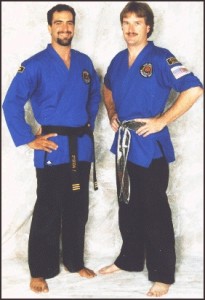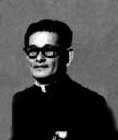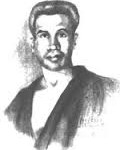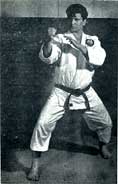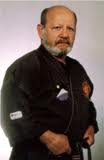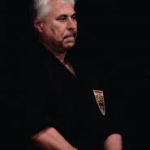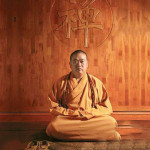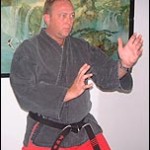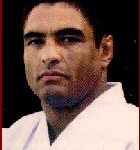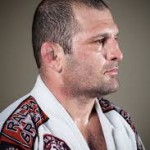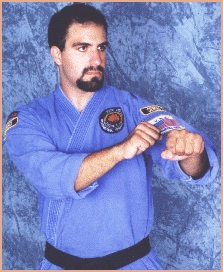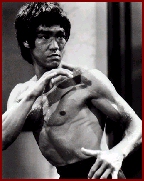SYSTEM 5 AMERICAN COMBAT KARATE
The system was developed in the 1970’s by Grandmaster’s Bruce and Dan Norris (no relation to Chuck). Master Sensei Steve Fossum (Right with Mr. Woodall) is the sole inheritor of the system holding the rank of 9th degree Black Belt (Masters rank). Mr. Fossum also holds a 2nd degree Black Belt in Tae Kwon Do and a 1st degree Black Belt in Shotokan. The system was originally developed from five core arts: Kempo, Judo, Shotokan, Tae Kwon Do, and Kung Fu. Since Mr. Fossum took over the system he has added skills and training methods from many different styles. The system is also based heavily in the military training method STIHC (Pronounced STI-HICK, special training in hand to hand combat). STIHC training was developed and used to train the elite special forces units of our military. Mr. Fossum holds a civilian certification to teach STIHC to military special forces units. Mr. Fossum is also the President of the largest kickboxing sanctioning body in the world (International Kick-boxing Federation, IKF).
You can read more about System 5 Karate and the IKF by looking on their website at www.ikfkickboxing.com. Mr. Woodall received his 4th degree Black Belt directly under the tutelage of Master Sensei Steve Fossum. Mr. Woodall continues to cross train in System 5 with a few of the other Black Belts under Mr. Fossum.
SHAOLIN KEMPO
The origins of Kempo/Kenpo have been the subject of debate since the late James Mitose passed away in Folsom Prison. For the purposes of simplicity, the following information is a very basic outline of the Shaolin Kempo lineage. It is generally accepted that Kenpo was developed in the Shaolin Temple (called Chuan Fa) and carried over to Japan in 1560 by a Shinto priest. The art was brought into the Mitose family where it was given the name “Kempo” (which translates into “fist law” or “Chuan Fa” in Chinese). The art was passed down through the Mitose family and James Mitose taught the art to William K. S. Chow. Mr. Chow taught Edmund Parker, who is considered by most to be the father of American Karate Kenpo.
Mr. Parker brought Kempo/Kenpo to the states in 1954 where he continued to revise the system. Mr. Parker taught Nick Cerio, who had training in various other martial arts. Mr. Cerio was introduced to William K. S. Chow by Mr. Parker. Mr. Cerio then spent several years traveling to Hawaii to train directly under William K. S. Chow. Mr. Cerio attained several high ranks under many different instructors. He was personally promoted by William K. S. Chow to the rank of 5th degree Black belt. The rank of Grandmaster (10th degree Black Belt) was awarded to Mr. Cerio in 1989 by the world counsel of sokes.
Mr. Cerio promoted Charles A. Mattera to the rank of 9th degree Black Belt. This was the highest certification of rank ever given out by Mr. Cerio. Master Mattera founded and heads the “United Studio’s of Self Defense,” one of largest martial arts organization in the United States.
In June of 2000, Master Mattera traveled to the Shaolin Temple and received his Grandmasters rank (10th degree Black Belt) directly from Great Grandmaster Shi Yongxin (the Abbot of the ShaolinTemple). Mr. Woodall’s Kempo instructor (Mr. Christopher De Freese) has a 4th degree Black in Shaolin Kempo. Mr. Woodall received his Black Belt directly under the instruction of Mr. De Freese, who now teaches privately.
BRAZILIAN JIU-JITSU
Mr. Woodall has had the privilege of training directly under Ralph Gracie from November of 1997 to November of 1998. in 1997 Mr. Woodall furthered his training with Rickson Gracie Black Belt David Terry. Mr. Woodall currently trains under one of the world’s top Black Belts, Cassio Werneck. Mr. Woodall currently holds the rank of Blue belt in Brazilain Jiu-Jitsu to which he was promoted by Mr. Werneck.
There is simply no better art available to teach you how to survive a grappling situation. In 1914, Japanese Jiu-jitsu champion Esai Maeda arrived in Brazil where he developed a relationship with the Gracie family. Maeda taught his Japanese system to Carlos Gracie and Carlos instructed his brothers Oswaldo, Gastao, Jorge, and Helio. In 1925 they opened the first Jiu-jitsu Academy in a district of Rio de Janeiro. Helio Gracie revolutionized the old Japanese system into the modern Gracie Jui-jitsu system that is taught today. Rickson Gracie is a 7th Degree Black belt in the family system and is the youngest son of Helio’s first marriage.
LAW ENFORCEMENT BACKGROUND
Mr. Woodall is a certified instructor in the following Law Enforcement Impact Weapons: Midrange Baton, Long range Baton, Expandable Baton, Side Handled Baton (Tonfa),Yawara Stick (or Kubaton), OPN (police Nunchaka), and the Short Billy Club. The system from which the training was derived from is called Aiki-Jujitsu. This system is a mixture of the arts of Aikido and traditional Jujitsu.
These traditional arts have been modified to be adaptable for the situations that police officers encounter on the street. The instructor of the system is Don Cameron. Mr. Cameron has over 30 years of experience in the field of training law enforcement officers and is considered an expert in court room testimony in use of force issues relating to all aspects of force used by police officers.
A BRIEF HISTORY OF THE MARTIAL ARTS
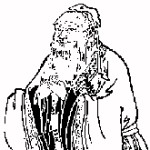 Most historians agree that the oldest recorded organized system of martial arts belongs to the Greek art called Pankration. The word Pankration translates into “all powers.” In 648 B.C.E., Pankration was officially entered into the Olympic Games, almost a century after the founding of the Olympics in ancient Greece. Prior to that, in approximately 350 B.C.E. the famous Philosopher, Plato, wrote about a martial art type “war dance” in a passage from Laws. Some historians argue that the Indian vajramushti system is the oldest system. However, Pankration and Plato’s writings predate the Indian statues depicting temple guards in poses similar to those used in latter day fighting arts. To add more controversy to the debate, archaeologists have unearthed a series of Babylonian plaques depicting figures in fighting stances using counter-blocking techniques. These plaques date back more than 5,000 years. This suggests that there was possibly a systemized method of unarmed fighting around the fertile crest in Mesopotamia.
Most historians agree that the oldest recorded organized system of martial arts belongs to the Greek art called Pankration. The word Pankration translates into “all powers.” In 648 B.C.E., Pankration was officially entered into the Olympic Games, almost a century after the founding of the Olympics in ancient Greece. Prior to that, in approximately 350 B.C.E. the famous Philosopher, Plato, wrote about a martial art type “war dance” in a passage from Laws. Some historians argue that the Indian vajramushti system is the oldest system. However, Pankration and Plato’s writings predate the Indian statues depicting temple guards in poses similar to those used in latter day fighting arts. To add more controversy to the debate, archaeologists have unearthed a series of Babylonian plaques depicting figures in fighting stances using counter-blocking techniques. These plaques date back more than 5,000 years. This suggests that there was possibly a systemized method of unarmed fighting around the fertile crest in Mesopotamia. 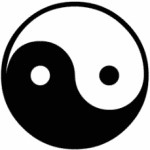 Perhaps this system moved eastward to India and then on further to China. How martial arts developed or progressed in-between the time of the Olympics and the sixth century A.D. is not well documented. The most popular account of what happened next in the evolution of the martial arts claims that in the sixth century A.D. Bodhidarma (the founder of what is now called Zen) traveled from India, across the Himalayas, to China. He ended up in the famous Shaolin Temple where it is believed that he introduced a system of 18 martial arts movements (known as the 18 hands of Lohan or muscle/tendon classic) to the monks. Bodhidarma died at the Shaolin Temple in 539 A.D. at the age of 57. Once again, some historians dispute aspects of the Bodhidarma account. Some historians like to point out that there are Chinese military manuals and documents dated from 206 B.C.E. to 220 A.D. that prove Han Emperors actively funded the study and refinement of the martial arts far beyond any of the known fighting systems in India during that time. In any account, few people try and dispute the fact that the most significant transformation in martial arts evolution took place under the roof of the Shaolin Temple. The Shaolin monks took the original movements that Bodhidarma showed them and evolved it into the Shaolin 5 Animals Styles (Tiger, Leopard, Dragon, Snake, & Crane). The monastery flourished for over a thousand years and through further development, accredited to Shaolin monks Gok Yuen, Lee Sau and Bak Juk Fung , the 18 Hands of Lohan (Lohan means a disciple of Buddha) was increased to 170 movements. In 1644 A.D. the Manchurians from Mongolia invaded China and overthrew the Ming Dynasty and set up the Ching Dynasty (1644-1911). Legend tells of 108 Shaolin monks defeating 10,000 Manchurians in a single afternoon. The monks began teaching martial arts for the first time outside of the temple walls to eager Chinese who were willing to fight the Manchurian rule. This helped start the spread and development of the martial arts heritage that many styles still practice to this day. Shortly after that, in 1647, the Shaolin monks were asked by Emperor K`ang-His to assist his troops in defeating the invading hordes attacking China’s eastern borders. The monks put together an army and were successful in thwarting the invasion. After witnessing the monks fighting prowess court officials convinced the emperor that he should disband the force of the fighting monks because they could be a threat to the throne. Eventually the emperor gave the order to destroy the temple. Aided by a renegade monk the emperors armies gained secret passage into the temple and all but 128 of the monks were killed. The temple was burned and the 128 surviving monks were hunted down and killed. Five monks escaped across the yellow river. Those surviving five monks vowed to set up their own monasteries as centers for resistance against the Ching Dynasty and went on to form the first triad secret society (Chinese equivalent to the Italian Mafia). They continued to spread the fighting arts of the Shaolin. Thanks to the cultivation of the martial arts in the Shaolin Temple we now have a deep and rich history of training that can be traced back over a thousand years. There are said to be over 300 distinct forms of Kung Fu taught in China today. Many of those systems still adhere to strict vows of secrecy and some systems are only taught to family members or full blooded Chinese. The majority of the popular systems taught publicly today can trace their arts beginnings back to the Shaolin Temple.
Perhaps this system moved eastward to India and then on further to China. How martial arts developed or progressed in-between the time of the Olympics and the sixth century A.D. is not well documented. The most popular account of what happened next in the evolution of the martial arts claims that in the sixth century A.D. Bodhidarma (the founder of what is now called Zen) traveled from India, across the Himalayas, to China. He ended up in the famous Shaolin Temple where it is believed that he introduced a system of 18 martial arts movements (known as the 18 hands of Lohan or muscle/tendon classic) to the monks. Bodhidarma died at the Shaolin Temple in 539 A.D. at the age of 57. Once again, some historians dispute aspects of the Bodhidarma account. Some historians like to point out that there are Chinese military manuals and documents dated from 206 B.C.E. to 220 A.D. that prove Han Emperors actively funded the study and refinement of the martial arts far beyond any of the known fighting systems in India during that time. In any account, few people try and dispute the fact that the most significant transformation in martial arts evolution took place under the roof of the Shaolin Temple. The Shaolin monks took the original movements that Bodhidarma showed them and evolved it into the Shaolin 5 Animals Styles (Tiger, Leopard, Dragon, Snake, & Crane). The monastery flourished for over a thousand years and through further development, accredited to Shaolin monks Gok Yuen, Lee Sau and Bak Juk Fung , the 18 Hands of Lohan (Lohan means a disciple of Buddha) was increased to 170 movements. In 1644 A.D. the Manchurians from Mongolia invaded China and overthrew the Ming Dynasty and set up the Ching Dynasty (1644-1911). Legend tells of 108 Shaolin monks defeating 10,000 Manchurians in a single afternoon. The monks began teaching martial arts for the first time outside of the temple walls to eager Chinese who were willing to fight the Manchurian rule. This helped start the spread and development of the martial arts heritage that many styles still practice to this day. Shortly after that, in 1647, the Shaolin monks were asked by Emperor K`ang-His to assist his troops in defeating the invading hordes attacking China’s eastern borders. The monks put together an army and were successful in thwarting the invasion. After witnessing the monks fighting prowess court officials convinced the emperor that he should disband the force of the fighting monks because they could be a threat to the throne. Eventually the emperor gave the order to destroy the temple. Aided by a renegade monk the emperors armies gained secret passage into the temple and all but 128 of the monks were killed. The temple was burned and the 128 surviving monks were hunted down and killed. Five monks escaped across the yellow river. Those surviving five monks vowed to set up their own monasteries as centers for resistance against the Ching Dynasty and went on to form the first triad secret society (Chinese equivalent to the Italian Mafia). They continued to spread the fighting arts of the Shaolin. Thanks to the cultivation of the martial arts in the Shaolin Temple we now have a deep and rich history of training that can be traced back over a thousand years. There are said to be over 300 distinct forms of Kung Fu taught in China today. Many of those systems still adhere to strict vows of secrecy and some systems are only taught to family members or full blooded Chinese. The majority of the popular systems taught publicly today can trace their arts beginnings back to the Shaolin Temple.
BRUCE LEE’S CONTRIBUTION TO THE MODERN MARTIAL ARTS
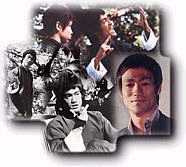
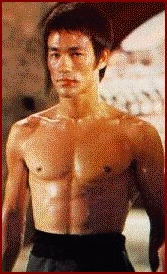 Bruce Lee had an enormous impact on modern martial arts. He was the first person to publicly argue the fact that traditional martial arts techniques are antiquated and simply do not prepare a student for survival on today’s streets. He felt that the traditional martial artist spent too much time kicking and punching in the air, as opposed to his preferred methods of training on bags and engaging in realistic contact training. When asked about his belt rank Bruce once said:
Bruce Lee had an enormous impact on modern martial arts. He was the first person to publicly argue the fact that traditional martial arts techniques are antiquated and simply do not prepare a student for survival on today’s streets. He felt that the traditional martial artist spent too much time kicking and punching in the air, as opposed to his preferred methods of training on bags and engaging in realistic contact training. When asked about his belt rank Bruce once said:
“I don’t have any belt whatsoever. Unless you can really do it, that belt doesn’t mean anything. I think it might be useful to hold up your pants.”
His biggest criticism of traditional martial arts was focused on the long hours spent on forms and kata training. This is clearly evident in a page written to a friend and student George Lee. Bruce Lee outlined a drawing of a miniature tomb and asked George Lee to make it for him for display purposes. The message on the tombstone read:
“In memory of a once fluid man crammed and distorted by the classical mess.”
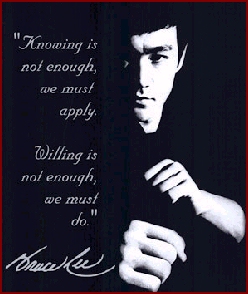 Bruce Lee broke away from the “classical mess” and not only changed martial arts but he was also on the forefront of state of the art training methods and equipment. He blazed the path for eclectic systems (such as the one taught here at our school) by being the first individual to condone cross training in the martial arts. It is written that Bruce Lee took aspects of 26 different martial arts to develop the theories he used to create Jeet Kune Do. He realized back in the early 1960’s what the martial arts community is just now starting to accept. You cannot be a one dimensional fighter. This has been proven over and over again in the world of reality fighting. You have to have good stand up skills and good grappling skills. The martial arts community has been forced to accept or at least acknowledge this fact by watching it unfold in front of them via reality based submission fighting. Bruce Lee was years ahead of his time and we are just now realizing how truly amazing and insightful he really was.
Bruce Lee broke away from the “classical mess” and not only changed martial arts but he was also on the forefront of state of the art training methods and equipment. He blazed the path for eclectic systems (such as the one taught here at our school) by being the first individual to condone cross training in the martial arts. It is written that Bruce Lee took aspects of 26 different martial arts to develop the theories he used to create Jeet Kune Do. He realized back in the early 1960’s what the martial arts community is just now starting to accept. You cannot be a one dimensional fighter. This has been proven over and over again in the world of reality fighting. You have to have good stand up skills and good grappling skills. The martial arts community has been forced to accept or at least acknowledge this fact by watching it unfold in front of them via reality based submission fighting. Bruce Lee was years ahead of his time and we are just now realizing how truly amazing and insightful he really was.
Not only was Bruce Lee an incredible martial artist, he was a scholar. He studied Philosophy at the University of Washington and his personal library of books was said to be in excess of 2000. This is one aspect of the traditional martial arts that very few martial artist still adhere to. Many of the greatest martial artists were also scholars and monks. In China, knowledge is guarded for only those chosen few who will use it properly. The knowledge of the martial arts has been cloaked in secrecy throughout its development. Bruce Lee broke the secrecy barrier and began teaching Americans the fighting secrets of Chinese martial arts.
In January of 1963, Wong Jak Man arrived in Bruce Lee’s Oakland school and challenged him to fight or close his school because he was teaching non-Orientals. Bruce’s wife, Linda Lee Caldwell, witnessed the fight. Bruce won the fight but it is reported to have taken several minutes for him to beat his opponent. It was at this point that he began to change and alter his training methods to create a new, more practical form of martial arts. Since he won the fight he was allowed to continue teaching whoever and however he wanted.If he were still alive today, I am sure Bruce Lee would be continuing to refine his art, and by doing so, leading the forefront of modern martial arts training.
” I cannot teach you, only help you to explore yourself. Nothing more.”
Bruce Lee
References: United Studios of Self Defense web site: www.ussd.com/lineagecerio.asp.Reference: Lewis, Peter (1987). Martial Arts. New York : Gallery Books. References: 1) Little, John (1996). The Warrior Within. Chicago : Contemporary Books. 2) Corcoran, John & Farkas, Emil (1977). The Complete Martial Arts Catalogue. New York : Simon & Schuster. 3) Bleecker, Tom (1996). Unsettled Matters. California : Gilderoy Publications.
